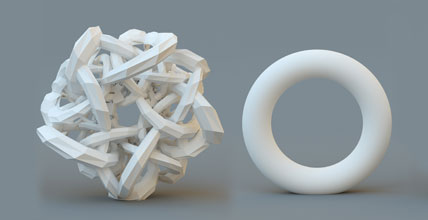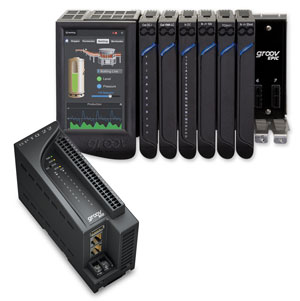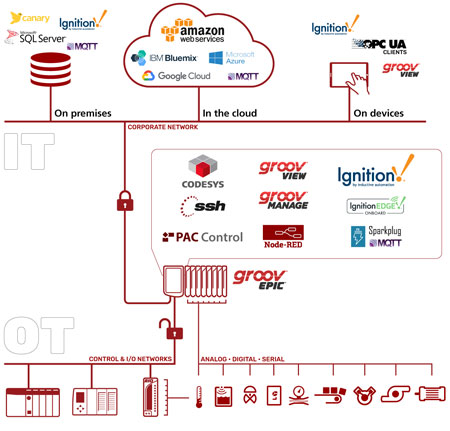- By Josh Eastburn
- May 31, 2020
- Connectivity And Cybersecurity
Summary
Fast Forward
- End users, OEMs, and systems integrators are looking for IIoT solutions that have the remote connectivity and data access they need.
- The traditional technology stack suffers from complexity and a lack of security.
- Today’s technology stack uses edge computing to make IIoT connectivity secure, scalable, and easy to implement.
Different industrial users have different IIoT goals, but they can all benefit from a simplified connectivity approach
By Josh Eastburn 
The Industrial Internet of Things (IIoT) means different things to different people. End users from all sorts of industries and businesses incorporate IIoT elements to realize value in ways that suit their unique needs.
In the most general terms, implementing an IIoT strategy involves connecting sensors and automated systems located in challenging manufacturing and process locations to create a unified data network. This enables extensive remote monitoring and data acquisition, deeper operational analysis, and autonomous machine-to-machine interaction. Common goals for users are smarter operations, improved equipment effectiveness, and cost reduction. But whether the user is the operations or engineering group in a plant, an original equipment manufacturer (OEM) who builds manufacturing machinery, or perhaps a systems integrator (SI) tasked with tying it all together, everyone agrees that IIoT implementation should be easy and secure.
At the simplest level, IIoT implementation involves getting field data into cloud systems so it can be processed and shared among many users and applications. That data is most often the domain of operations technology (OT) personnel and systems, conventionally incorporating devices like programmable logic controllers (PLCs), human-machine interfaces (HMIs), and supervisory control and data acquisition (SCADA). While these OT systems can perform a certain amount of computing in the field, or transmit raw data over to the information technology (IT) side of the business for additional processing, they are not very good at either compared with modern options.
This article discusses how new options for industrial edge computing provide a simple and secure alternative approach to achieving different IIoT connectivity objectives. It presents the general architectural improvements that edge computing affords and explores their application in solving the specific challenges of the three user groups mentioned above: plant operations and engineering teams, OEMs, and SIs.

Who wants what?
While everyone is looking for solutions that are good, fast, and cheap, those three attributes rarely intersect. A better way to define the attributes of a robust and optimal IIoT solution is to examine the needs and goals of different end user groups.
Operational end users. End users at manufacturing businesses and production plants all need good data. There are operators who rely on visualization to run their plants on a daily basis, process engineers who want to optimize operations, plant engineers who will expand systems when necessary, and maintenance teams who troubleshoot and correct issues. A good IIoT implementation automatically delivers the right information to the right person at the right time.
Original equipment manufacturers. OEMs create the machinery and equipment operated by end users. They are experts in the equipment they build and automate, but once a machine ships it is not under their direct control on their own site; it could be anywhere in the world. To build better machines and improve support to existing clients, OEMs need IIoT solutions that enable remote connectivity and have the ability to gather performance data for troubleshooting and continuous improvement. The right IIoT implementation will connect them with a highly distributed fleet of equipment across disparate networks and security schemes.
Systems integrators. Of all the parties interested in using IIoT connectivity, SIs likely have the most automation specialists on board, with skill sets spanning platforms, technologies, and industries. Typically, however, they are also the service providers and subject-matter experts (SMEs) for a large customer base. They are tasked with the constant demand to win new business and provide long-term support for previous projects. Effective IIoT solutions will give them cost-effective and efficient ways to deliver systems to their customers, including proven security and multiple communication options for broad interoperability and remote access.
A design profile that satisfies the needs of all these parties will include, to varying degrees:
- flexible scalability
- high interoperability
- embedded security
- good performance relative to cost
- low administration and high maintainability
The complexity and expense associated with the current OT solution set oftentimes keeps end users from fully realizing these goals. In the next section we will examine some of the inherent limitations of the conventional approach.

Traditional architectures have lots of layers
Lots of layers in a birthday cake, lasagna, or bean dip are usually considered a good thing, but it is exactly the opposite situation for industrial communication architectures. In these cases, more layers mean more devices, physical connections, configurations, programming, bottlenecks, and single points of failure. Yet traditional architectures have needed all these things to bring even one data point up to the cloud (figure 1).
A simple alarm contact or field sensor is most often wired into a PLC, which is programmed to accept the signal and perhaps scale it. More code is needed to get this signal into the HMI or SCADA system, with yet more code and networking required to transfer the signal to the cloud.
Once commissioned, these connections can be unreliable and difficult to troubleshoot. Additionally, the poll-and-response communications, manual data mapping, and lack of embedded data context make these connections cumbersome to configure and expand. Legacy products and older protocols offer little or no security and can become progressively more unwieldy as time progresses. Software updates to one link in the chain, for example a PC-based HMI or SCADA system, can negatively affect communications.
Some IIoT data connectivity goals can be achieved with traditional technologies, but only after applying great effort and settling for many caveats. The main barrier raised by conventional approaches is complexity, which leads to costly hardware, software, and labor for the initial design and sustaining operation. For early adopters trying to obtain data from the automation edge before the rise of the IIoT concept and its underlying technologies, it is clear how challenging the task could be.

Flatter architectures, newfound capabilities
Hardware, software, and communication technologies are progressing and harmonizing to make IIoT implementations practical for any type of end user and application. An important design technique underlying this evolution is called edge computing. It addresses some of the key challenges faced by end users by shifting the traditional communication hierarchy described previously toward a more distributed model.
Traditionally, OT hardware has used proprietary protocols and media with a relatively limited scope of operation. This fact has led to the previously described problems associated with complex, layered system architectures, which were required to facilitate data processing and transmission. In the edge computing model, however, the data demands of large networks are served by embedding more computing power in the field, where data is produced. Rather than requiring a deep technology stack to move data from limited field devices to powerful central computing resources, edge computing devices are capable of processing data directly at the source and then transmitting it wherever it needs to go.
Industrial edge computing hardware addresses the complexity and security concerns of end users by flattening the communication architecture and introducing up-to-date IT standards to the OT domain. For instance, a traditional wired sensor can be connected directly to a field-installed, remote edge I/O device, which will establish an encrypted, certified connection directly to the cloud and transmit the signal data securely through its own internal firewall (figure 2). This avoids the complexity of traditional systems, which would have required interposing PLCs, PCs, and security hardware.
For applications where users need control logic or more advanced computing in the field, they can use an edge programmable industrial controller (EPIC) for this purpose and still have the same connectivity experience. EPICs perform the same real-time control tasks as classic PLCs and PACs but also natively incorporate secure modern management and IIoT communication (figure 3). Because of their more powerful computing capability, they can also function as communication gateways for legacy PLCs and assimilate other automation functions, like HMI visualization or database hosting, further reducing the complexity of the control network.
Edge computing devices support wired Ethernet and Wi-Fi in various configurations, and typically include support for other IT standards like domain name system (DNS), dynamic host configuration protocol (DHCP), virtual private networking (VPN), and secure shell (SSH) access. These features make it easy to install, configure, and access devices locally or remotely in almost any infrastructure setting, but more importantly they help to close the skill gap between OT and IT. SMEs from both domains can work with a common set of tools to manage automation and business networks, reducing the cost of labor and maintenance, and allowing data to move seamlessly across the organization.
As opposed to PCs and other consumer- or enterprise-grade devices, however, industrial edge hardware is constructed to withstand the physical space constraints and environmental conditions found in the field (figure 4) with appropriate certifications for hazardous environments.
Unique software and communication developments also feature heavily in the portfolio of technologies for enabling IIoT capabilities. Edge computing devices allow these technologies to be embedded directly in the field, including support for OPC, an industry-standard method for connecting with heterogeneous devices, and MQTT (formerly MQ Telemetry Transport) with Sparkplug B, the popular and efficient IoT-specific communications protocol with extensions for mission-critical applications. Edge devices may also include support for IoT tools like Node-RED, an open-source IoT programming language, providing a low-code way for users to combine data from web services, devices, applications, and databases.
Combined, these edge computing hardware and software technologies support a flatter and simpler architecture, which delivers more functionality than classic layered architectures.
Simplified IIoT resonates with all end users
In contrast with traditional architectures, edge computing provides a completely scalable approach to digital transformation. For brownfield sites, operational users can install edge computing devices incrementally and in parallel with existing automation, giving them a migration path that avoids process interruptions. Engineers can expand the data network over time without large, upfront investments in infrastructure, making it easier to bring valuable data to users and applications.
Combined with embedded technologies like VPN and MQTT, edge computing also enables OEMs to offer new support options. Using an EPIC as the native control platform, they can perform routine checks, upgrades, and service calls by connecting directly to their controller online instead of in person. With embedded security, OEMs can also gather extensive operational data on their installed base of equipment safely over the public Internet. Over the long haul, this data can be used to expose operating trends, so their equipment can be fine-tuned, or even receive beneficial design modifications.
SIs will find that industrial edge computing creates a reliable, cost-effective foundation for their IIoT projects that is applicable to all types of machines and processes. As with the other user groups mentioned, edge computing devices simplify remote support for SIs and facilitate integration with legacy control systems and devices. The combination of streamlined infrastructure, network-oriented security at the device and control level, and support for IIoT interoperability technologies like MQTT and OPC UA helps them deliver the kinds of functionality, visibility, and insights their clients want at a price that wins more business.

Simple and secure
Applying IIoT technologies to obtain valuable remote connectivity and data communications is attractive to operational end users, OEMs, and SIs. Each of these groups has certain needs specific to their role, and they all can benefit from simple and secure solutions.
The traditional hardware and software technology stack has made previous IIoT endeavors difficult due to legacy products, a multitude of layers, and a lack of security. Today’s technology stack combines IT-friendly edge computing hardware and software to address these and other issues. By flattening the architecture and offering built-in security and communication options, end users of all types can easily deploy edge computing to achieve their goals.
Reader Feedback
We want to hear from you! Please send us your comments and questions about this topic to InTechmagazine@isa.org.


